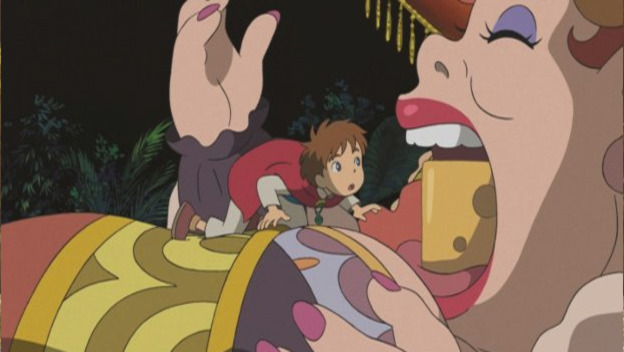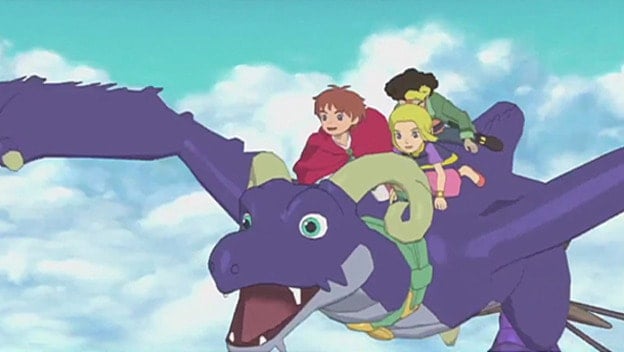Ever since the Game Boy let us stuff cute little magic animals into balls and make them fight for our amusement, JRPG developers have been trying to shoehorn monster-capture systems into their games. Unfortunately, this usually comes off as a gimmick and is received quite poorly by JRPG fans. Luckily Ni No Kuni, the amazing JRPG opus by Level-5, has come along to show us how to do it right. What makes Ni No Kuni’s monster raising system different from all the others we have seen in the past? Well, here are five observations I’ve made so far that might shed some light on that.
1. It Fits Within the Context of the Story and Setting
In Ni No Kuni, you take on the role of Oliver, a young wizard who is destined to save a magical alternate world. Your monsters are your wizardly familiars, creatures made of life-force that use your power and fight in your stead. In the Ni No Kuni universe, using familiars is just something wizards can do; it’s not exclusive to Oliver. As you travel the world, you will meet plenty of other wizards who use familiars as well. Your allies use familiars. Your other party members use familiars. Your enemies use familiars. Heck, even NPCs use familiars. Before you even get your first familiar, you gain access to a book that explains the long and storied traditions of familiar use in the wizarding world.
Compare this to, say, Tales of Symphonia: Dawn of the New World or Final Fantasy XIII-2, in which the ability to tame and raise monsters is just something the main character can do. It’s mentioned once in the story and a few tutorials, but never becomes important to the narrative. It’s essentially a hollow mechanic that means nothing, and so it feels like a cheap gimmick.
2. It Doesn’t Diminish the Importance of the Main Characters
The familiars of Ni No Kuni are awesome and integral to the gameplay, but they aren’t the main characters in the game. Oliver and his companions are, and so they too are integral to the gameplay. Every battle starts with either Oliver or his companions issuing a command. Familiars have limited stamina, thus requiring you to frequently switch between them and your human party members. Human party members can fight just as well as familiars can, and since all familiars share HP and MP with the character that summons them, it’s important that you don’t neglect your main characters’ stats and equipment as well.
This makes Ni No Kuni far more like the Persona series than any other monster-raising game. Even though you are fighting with monsters, the focus of battle is always on the main characters themselves. It feels as if it is the characters who are winning or losing the battle, not the familiars. In a sense, it feels like the familiars couldn’t exist without the main characters in the first place.
3. The Monsters Aren’t Replacements For Other Party Members
As I said before, controlling familiars is just something a wizard does in Ni No Kuni’s universe. So each familiar in your party is attached to another wizard. Each of these wizards, Oliver, Esther, Swaine, and more, has a personality and a backstory, and all of these characters stick with you through much of the game. You aren’t raising monsters instead of controlling party members; you’re doing both at once.
Meanwhile, look at Final Fantasy XIII-2. Your party consisted of Serah, Noel, and whatever monster you happened to come by. Similarly, in Tales of Symphonia: Dawn of the New World, your party was Emil, Marta, and whatever two monsters you liked. There was no reason XIII-2 couldn’t have let notable characters like Hope or Snow join your party. ToS sometimes did let other characters into your party, but it didn’t let you raise them in any significant way, so using them was relatively pointless. Both of these sequels effectively reduced every single main character from their predecessor to window dressing for the sake of introducing a monster-raising system. In both cases, this came off as more than a little bit lazy.
4. The Monster-Raising System Creates More Options, Not Less
In Ni No Kuni, you control a party of three wizards, each with their equipment and abilities. These wizards can switch between three familiars, also with their own equipment and abilities. This essentially allows you to switch between a whopping twelve different sets of equipment and abilities, all mid-battle.
Meanwhile, in Final Fantasy XIII-2, each of the monsters in your third party slot had fewer abilities than your main characters had in their Crystarium trees. In Tales, each monster had far fewer artes and abilities then full-fledged party members. Neither of these games actually let you fool around with your monster’s equipment much. In the end, it feels like monsters are the next best thing to a party member, not a full-fledged member of the party itself.

5. The Whole System Can Be Completely Ignored
And now for the biggest factor: Ni No Kuni’s monster-raising system, despite all the praise I have given it, can be completely ignored. You can play through the entire game with your starting roster of monsters and you will be just fine. Heck, you can play through the entire game using only your human player characters if you really want to, though that might prove fairly difficult. The system is there for the people who want It and not for those who don’t. Completionists will attempt to capture every familiar in the game, while more traditional RPG players will simply choose a roster that works and push toward the end of the game.
Meanwhile, other monster-raising games make it a point to force you to raise monsters. There will be level or evolution caps that prevent you from using the same monsters you used at the beginning of the game in the end game. More often than not, low-level monsters will stop learning useful abilities after ten or so levels, forcing you to switch up your team.
Here’s my final word on this: If a game builds an interesting monster-raising system, it doesn’t need to force players to use it. Players will want to use it because it is interesting. Moreover, if they choose to play the game in a way that ignores the core system, it might be a sign that the core system could have been implemented better. This is where Ni No Kuni excels the most. It crafted an incredibly interesting system of monster raising based around the narrative and had the confidence to say, “Use it if you like; ignore it if you don’t.” And we loved it.
 | By Angelo M. D’Argenio Lead Contributor Date: February 6, 2013 |
